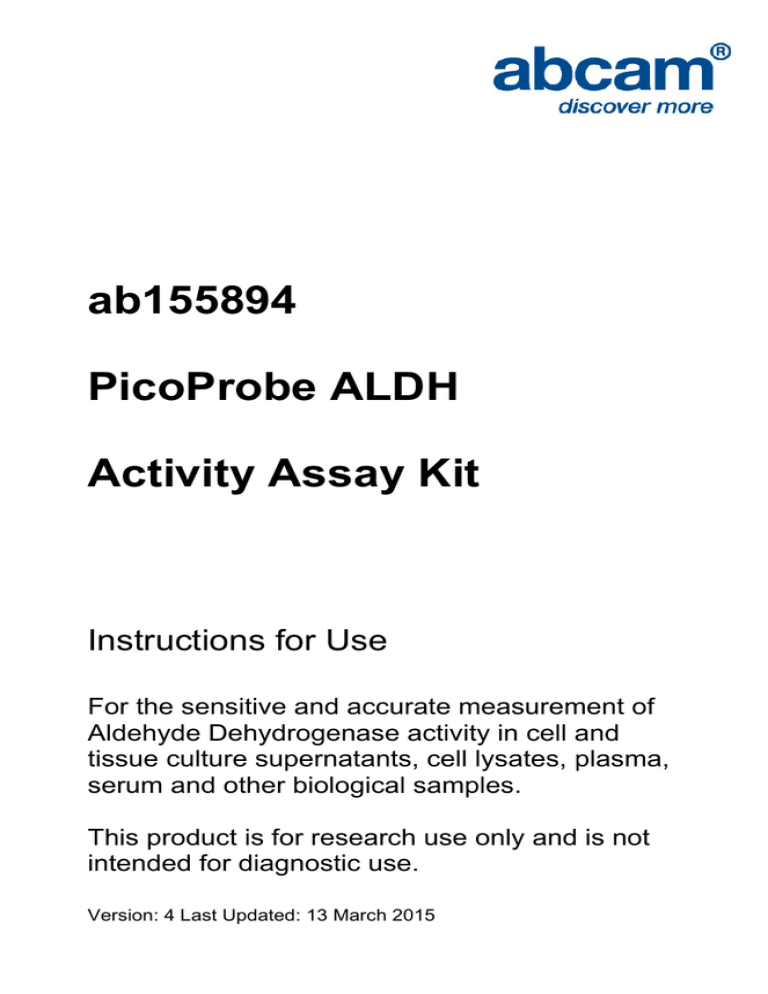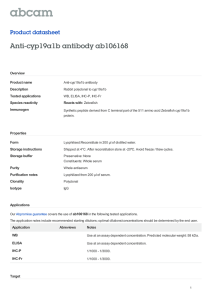
ab155894
PicoProbe ALDH
Activity Assay Kit
Instructions for Use
For the sensitive and accurate measurement of
Aldehyde Dehydrogenase activity in cell and
tissue culture supernatants, cell lysates, plasma,
serum and other biological samples.
This product is for research use only and is not
intended for diagnostic use.
Version: 4 Last Updated: 13 March 2015
1
Table of Contents
1.
Overview
3
2.
Protocol Summary
4
3.
Components and Storage
5
4.
Assay Protocol
6
5.
Data Analysis
9
6.
Troubleshooting
11
2
1. Overview
The NAD-dependent Aldehyde Dehydrogenase (ALDH) plays a vital
role in cellular detoxification. It oxidizes various aldehydes and
generates the corresponding carboxyolic acid. ALDH have been
found in every cellular compartment. Based on its structure and
function, ALDH comprises 3 major classes in mammals: Class 1 and
Class 3 (the tumor form) are located in the cytosol and include both
constitutive and induced forms; Class 2 is located in the
mitochondria and only exists as the constitutive form. In humans, the
ALDH superfamily consists of 19 genes. The mutation of ALDH
genes (loss of function) causes human diseases such as Type II
hyperprolinemia,
hyperammonemia.
pyridoxine-dependent
seizure
and
Recent studies show that increased ALDH
activity leads to several types of malignancies, serves as a cancer
stem cell marker and correlates with poor prognosis. Therefore the
early detection of ALDH activity levels can be prognostic and guide
the therapeutic strategies.
Abcam’s PicoProbe ALDH Activity Assay Kit is a robust tool to
quantify ALDH enzymatic activity. In this assay, acetaldehyde is
oxidized by ALDH to form the NADH which couples with the
PicoProbe to generate a potent fluorescence (Ex/Em = 535/587).
The ALDH fluorometric assay kit is 10 times more sensitive than the
ALDH colorimetric assay and can detect < 0.05 mU ALDH activity
(based on our unit definition) in a variety of samples.
3
2. Protocol Summary
Reagent Preparation
Standard Curve Preparation
Sample Preparation
Positive Control
Reaction Mix
Measurement and Calculation
4
3. Components and Storage
A. Kit Components
Item
Quantity
ALDH Assay Buffer
25 mL
Acetaldehyde
0.5 mL
PicoProbe Probe (in DMSO)
0.4 mL
ALDH Substrate Mix (lyophilized)
1 vial
ALDH Positive Control (lyophilized)
1 vial
NADH Standard (0.5µmol, lyophilized)
1 vial
* Store the kit at -20°C and protect from light. Please read the entire
protocol before performing the assay. Avoid repeated freeze/thaw
cycles.
Warm ALDH assay buffer to room temperature before use. Briefly
centrifuge all small vials prior to opening.
5
B. Additional Materials Required
96-well clear plate with flat bottoms
Multi-well spectrophotometer (ELISA reader)
Glycerol
4. Assay Protocol
A. Reagent Preparation
1. ALDH Assay Buffer and Acetaldehyde:
Store at -20°C.
2. Aldehyde Dehydrogenase Substrate Mix:
Reconstitute with 220 µl ALDH Assay Buffer. Pipette up and
down to completely dissolve. Store at –20oC. Use within two
months
3. ALDH Positive Control:
Reconstitute with 220 µl Assay Buffer containing 20 % glycerol
(not included). Pipette up and down to completely dissolve,
aliquot & store at -20°C. Avoid repeated freeze and thaw cycle.
6
4. NADH Standard
Reconstitute with 500 µl dH2O to generate 1 mM NADH. Aliquot
and store at -20°C. Avoid repeated freeze/thaw cycles.
B. ALDH Assay Protocol
1. NADH Standard Curve:
Dilute the NADH Standard to 0.05 mM by adding 10 µl of the
NADH to 190 µl Assay Buffer and mix well. Add 0, 2, 4, 6, 8, 10
µl into a 96 well plate in duplicate to generate 0, 100, 200, 300,
400, 500 pmol/well standards, adjust volume to 50 µl /well with
ALDH Assay Buffer. For samples having very low ALDH activity,
Add 0, 1, 2, 3, 4, 5 µl into a 96 well plate in duplicate to generate
0, 50, 100, 150, 200, 250 pmol/well standards, adjust volume to
50 µl /well with ALDH Assay Buffer.
2. Sample preparation:
Liquid samples can be measured directly. Tissue (50 mg) or
cells (1 x 106) should be rapidly homogenized with ~ 200 µl ice
cold ALDH Assay Buffer for 10 minutes on ice, then spun down
at 12000 rpm for 5 min to remove nuclei and insoluble material.
Add 1 - 50 ul of the collected supernatant into a 96 well plate and
adjust the final volume to 50 µl with ALDH Assay Buffer.
Notes: For unknown samples, we suggest testing several doses
of your samples to ensure the readings are within the Standard
Curve range. NADH in samples will generate a background
7
reading. Background readings can be corrected by omitting the
Acetaldehyde in the Reaction Mix as a background control. For
the optional Positive Control, dilute the reconstituted Positive
Control 10-fold in Assay Buffer then use use 5 -10 µl and adjust
the final well volume to 50 µl with Assay Buffer.
3. Reaction Mix:
Mix enough reagent for the number of samples and standards to
be performed. For each well, prepare a total 50 µl Reaction Mix
containing:
ALDH
Background
Measurement
Control
ALDH Assay Buffer
39 µl
44 µl
PicoProbe**
2 µl
2 µl
Substrate Mix
2 µl
2 µl
Acetaldehyde
5 µl
__
Add 50 µl of the Reaction Mix to each well containing the NADH
Standard, test samples and background controls, mix well.
**Note: For NADH standard curve or samples which will
generate less than 250 pmol NADH, reduce the probe volume to
1 µl per well to reduce reagent background and increase the
assay buffer accordingly.
4. Measurement
8
Incubate at room temperature for 5 minutes protected from light.
Measure the RFU of samples and sample backgrounds at
Ex/Em 535/587 nm (RFU1 & RFU1B) then measure the RFU at
Ex/Em 535/587 nm (RFU2 & RFU2B) again after 20 - 60 min
depending on the ALDH activity in the samples. NADH
standards can be measured at the end point. We suggest
measuring the samples in a kinetic mode (every 2 - 3 min) and
picking the linear range within the NADH Standard Curve.
5. Data Analysis
Calculation: Subtract the 0 Standard reading from all Standard
readings and plot the Standard Curve. Apply sample ∆RFU 450nm
[(RFU2 - RFU2B) - (RFU1 - RFU1B)] to the Standard Curve to get
B pmol of NADH generated during the reaction time (∆T= T2 - T1).
ALDH Activity
=
Sample
x Dilution
(ΔT x V)
Factor
B
= pmol/min/ml = µU/ml
Where:
B is the amount of NADH generated in your sample (pmol).
ΔT is the reaction time (min).
V is the sample volume (ml).
Unit Definition: One unit is the amount of enzyme that will generate
1.0 µmol of NADH per min at pH 8 at room temperature.
9
(a)
(b)
Figure 1: (a) NADH standard curve (b) Positive Control Timeline.
Assays were performed following kit protocol.
10
6. Troubleshooting
Problem
Reason
Solution
Assay not
working
Assay buffer at
wrong temperature
Assay buffer must not be chilled
- needs to be at RT
Protocol step missed
Plate read at
incorrect wavelength
Unsuitable microtiter
plate for assay
Unexpected
results
Samples
with
inconsistent
readings
Re-read and follow the protocol
exactly
Ensure you are using
appropriate reader and filter
settings (refer to datasheet)
Fluorescence: Black plates
(clear bottoms);
Luminescence: White plates;
Colorimetry: Clear plates.
If critical, datasheet will indicate
whether to use flat- or U-shaped
wells
Measured at wrong
wavelength
Use appropriate reader and filter
settings described in datasheet
Samples contain
impeding substances
Unsuitable sample
type
Sample readings are
outside linear range
Troubleshoot and also consider
deproteinizing samples
Use recommended samples
types as listed on the datasheet
Concentrate/ dilute samples to
be in linear range
Unsuitable sample
type
Refer to datasheet for details
about incompatible samples
Use the assay buffer provided
(or refer to datasheet for
instructions)
Samples prepared in
the wrong buffer
11
Problem
Reason
Solution
Cell/ tissue samples
not sufficiently
homogenized
Too many freezethaw cycles
Samples contain
impeding substances
Increase sonication time/
number of strokes with the
Dounce homogenizer
Aliquot samples to reduce the
number of freeze-thaw cycles
Troubleshoot and also consider
deproteinizing samples
Use freshly made samples and
store at recommended
temperature until use
Wait for components to thaw
completely and gently mix prior
use
Always check expiry date and
store kit components as
recommended on the datasheet
Samples are too old
or incorrectly stored
Lower/
Higher
readings in
samples
and
standards
Not fully thawed kit
components
Out-of-date kit or
incorrectly stored
reagents
Reagents sitting for
extended periods on
ice
Incorrect incubation
time/ temperature
Incorrect amounts
used
Standard
curve is not
linear
Not fully thawed kit
components
Pipetting errors when
setting up the
standard curve
Incorrect pipetting
when preparing the
reaction mix
Try to prepare a fresh reaction
mix prior to each use
Refer to datasheet for
recommended incubation time
and/ or temperature
Check pipette is calibrated
correctly (always use smallest
volume pipette that can pipette
entire volume)
Wait for components to thaw
completely and gently mix prior
use
Try not to pipette too small
volumes
Always prepare a master mix
12
Problem
Reason
Air bubbles in wells
Concentration of
standard stock
incorrect
Errors in standard
curve calculations
Use of other
reagents than those
provided with the kit
Solution
Air bubbles will interfere with
readings; try to avoid producing
air bubbles and always remove
bubbles prior to reading plates
Recheck datasheet for
recommended concentrations of
standard stocks
Refer to datasheet and re-check
the calculations
Use fresh components from the
same kit
For further technical questions please do not hesitate to
contact us by email (technical@abcam.com) or phone (select
“contact us” on www.abcam.com for the phone number for
your region).
13
14
UK, EU and ROW
Email: technical@abcam.com | Tel: +44(0)1223-696000
Austria
Email: wissenschaftlicherdienst@abcam.com | Tel: 019-288-259
France
Email: supportscientifique@abcam.com | Tel: 01-46-94-62-96
Germany
Email: wissenschaftlicherdienst@abcam.com | Tel: 030-896-779-154
Spain
Email: soportecientifico@abcam.com | Tel: 911-146-554
Switzerland
Email: technical@abcam.com
Tel (Deutsch): 0435-016-424 | Tel (Français): 0615-000-530
US and Latin America
Email: us.technical@abcam.com | Tel: 888-77-ABCAM (22226)
Canada
Email: ca.technical@abcam.com | Tel: 877-749-8807
China and Asia Pacific
Email: hk.technical@abcam.com | Tel: 108008523689 (中國聯通)
Japan
Email: technical@abcam.co.jp | Tel: +81-(0)3-6231-0940
www.abcam.com | www.abcam.cn | www.abcam.co.jp
Copyright © 2013 Abcam, All Rights Reserved. The Abcam logo is a registered trademark.
15
All information / detail is correct at time of going to print.
Copyright © 2013 Abcam, All Rights Reserved. The Abcam logo is a registered trademark.
All information / detail is correct at time of going to print.

